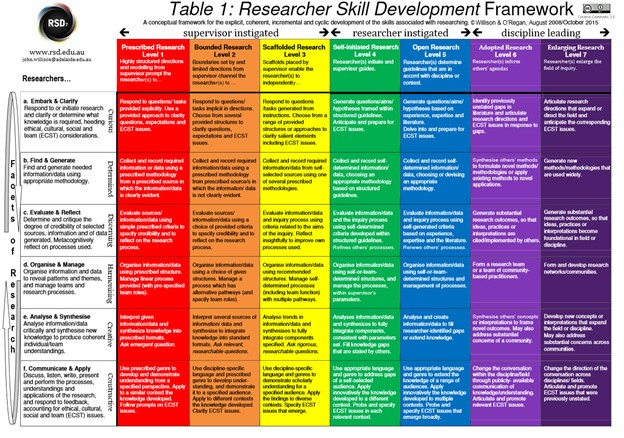
From Student to Researcher (in one Term!) Post 4: Intentionally integrating active learner reflection into the CURE course
In this post, we share how we use the Research Skills Development Framework version 7 (RSD7) developed by John Willison, University of Adelaide, as a tool for reflection within our CURE course.
By Harold Bull, Dawn Giesbrecht, and Sheryl Mills(This blog series is authored by USask denizens Harold Bull, Dawn Giesbrecht and Sheryl Mills) Harold is Assistant Professor Biochemistry, Microbiology & Immunology. Dawn is Laboratory Instructor Anatomy, Physiology and Pharmacology; Biochemistry, Microbiology and Immunology. Sheryl is Associate Director, Academic Programs & Interprofessional Education)
In this post, we share how we use the Research Skills Development Framework version 7 (RSD7) developed by John Willison, University of Adelaide, as a tool for reflection within our CURE course.
Thirteen weeks (one term!) goes by VERY quickly. Our inclination is often to just put our heads down and ‘get ‘er done’. By intentionally incorporating reflection we have the opportunity to:
- appreciate our accomplishments to date
- gain enthusiasm and momentum to carry us forward by building on our successes
- help us see what we did in the past and what can be even more effective going forward
Incorporating this practice within a research endeavor provides learners with a model for how to pause and reassess when things haven’t gone as initially hypothesized.
Sometimes we find it hard to see how far we have come. It can feel like we are never moving forward or making progress. Pausing to use the RSD7 Framework gave us all on opportunity to see progress along that continuum. This was encouraging for all of us!
How we incorporated RSD7
We asked learners midway through the first iteration of our CURE course to identify where they perceived themselves to be in each of the six categories. As a group we discussed where they had placed themselves on the continuum. We noticed that some learners had indicated being further along the continuum than one (we, the instructors) would have imagined from what we had observed…
This lead to a second question. We then asked learners to identify where they thought others would see them along the continuum. Interestingly, some learners lowered their estimates while others raised theirs. This lead to some insightful conversations and observations about how we can ‘show what we know and are able to do’ and to perhaps, rethink the estimates we have our own abilities. In addition to the midway point, we also had the learners self-assess at the end of the course and compare and reflect on their development as researchers.[1] Not only did we see our learners move from students to researchers in 3 cu, they also saw themselves shift!
Using the RSD Framework and seeing the observations of our learners was another ‘ah-hah!’ for us. We realized that intentionally guiding learners to reflect was a key element in their development as researchers, subsequent satisfaction and sense of achievement. We decided to introduce the framework into each of the subsequent iterations of the CURE course. Having a tool like the RSD7 Framework gave us a common and consistent language to reflect with.
We would recommend that having a tool to reflect with is useful, whether you find a tool like we did, or you create one.

Find ALL BLOG POSTS IN THIS SERIES HERE. Find previous post here and our next post here.
Podcasts:
[1] In future iterations of our CURE course we will be introducing the Framework in week 1 to obtain a baseline.

